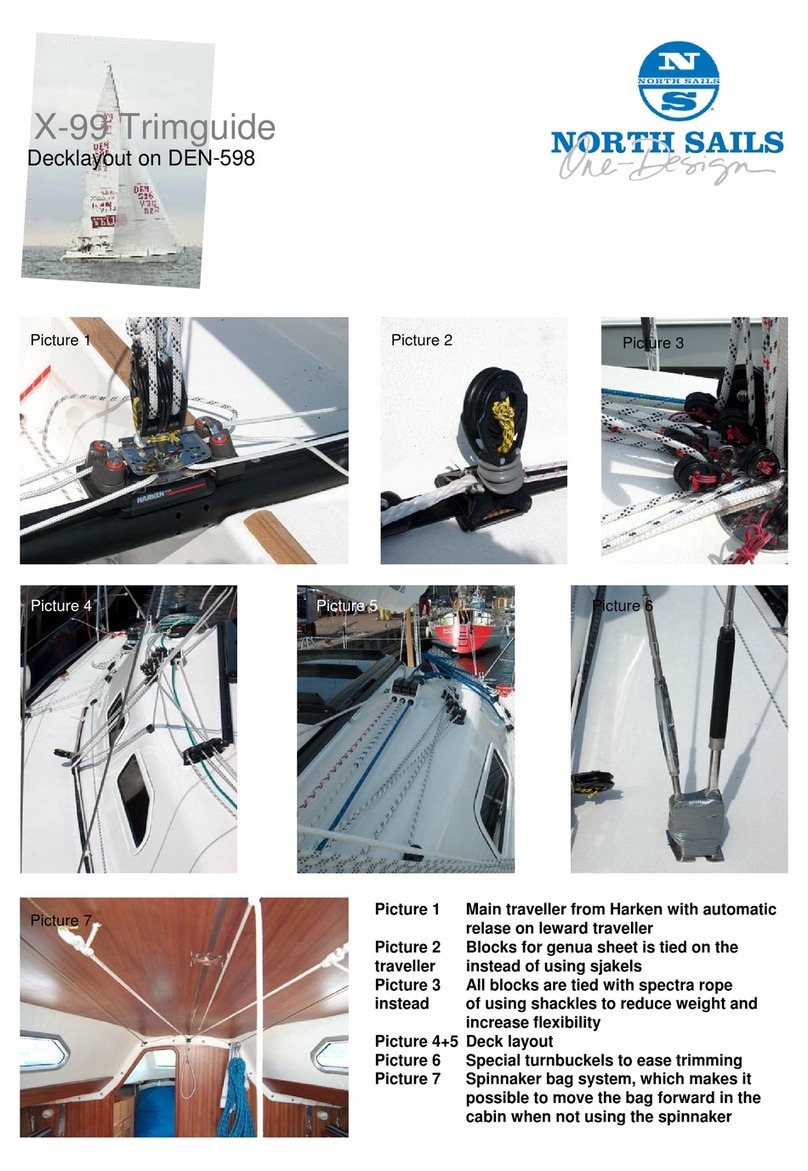Side 3/3
18-20 knots of true wind is the maximum for the no. 1 genoa, although this depends on the
waves; at higher wind speeds you should change to the jib.
3. Jib (VJ-4)
Due to the profile and the size the new jib is very suitable from 16-18 knots of true wind and
upwards. It is essential that the halyard tension is set as hard as it is necessary to keep the
camber permanent in the front of the sail. Otherwise you risk moving it backwards and the jib
gets a flat entry and backwinding the main with too low a halyard tension. Regarding the
sheeting, the wind and wave conditions are decisive as to how much power you wish to have in
the jib.
At 12- 15 m/sec you sheet to the top spreader. The foot has an even curve from the forestay to
the sheeting point. Y ou sheet in the Flrst holes of the genoa track. Halyard tension precisely as
much as you need to remove the wrinkles. Sheet so hard, so the leech just touches the downer
shroud at the leech line stop, close to the velcro tape.
In heavy conditions ( 15-20 m/sec) you sheet 10 cm from the top spreader. The foot is tight
from tack to clew. You sheet 1 or 2 holes back on the genoa track. Halyard tension precisely as
much as you need to remove the wrinkles.
4. Spinnaker (VSM-5 and VSI-4)
We have changed the opinion of many people by sailing with the max class spinnaker that is
used both as a reaching and running spinnaker. We have designed a special running spinnaker
with a big head, lots of broad seaming in the middle and big shoulders SQ VQU really can run
"dead downwind" with the sail. The spinnaker pole is at 900 on the mast in medium airs, to
avoid the spinnaker being covered by the main and becoming ineffective. Leeward barberhaul
is tensioned until there is 10- 15 cm between the spinnaker sheet and the mainsail boom.
While reaching with the little class spinnaker (VSI-4) the spinnaker pole must not come closer
to the forestay than 15-20 cm, otherwise you risk that the spinnaker flying to leeward the centre
line and dragging the boat to the side instead forward. This often happens due to the running
backstays being loosened before the spinnaker is set and therefore loosens the forestay.
In light conditions (0-3 m/sec) the spinnaker pole is in the lower eye of the mast, under 2 m/sec
you can optimise your sailing angles with the small spinnaker (VSI-4).
When gybing in heavy airs you loosen the kicking strap 10 cm to protect the mast and the rig.
You have to work a lot with the kicking strap while reaching to avoid too much pressure on the
rudder and therefore luffing.
The new spinnaker design has become fuller to avoid a "nervous" sail which collapses at the
tiniest change of the wind or trim.
The fuller design also makes it possible to use the spinnaker in light airs where you can reach
for a maximum V.M.G. Remember to lower the pole to tension the windward leech. It is much
easier to keep the small spinnaker flying than the large, which, due to its width, often will
collapse.
NORTH DIAMOND SAILMAKERS A/S
Sundkrogskaj 8
DK-2100 Copenhagen
DENMARK
Tel: +45 3920 4090






















